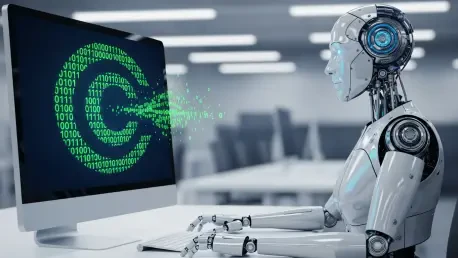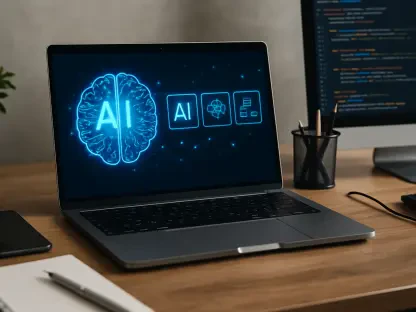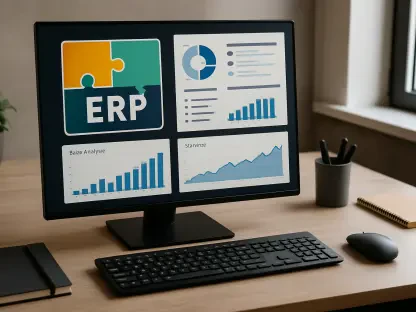Understanding the AI IP Crisis in Software Development
The software development landscape in 2025 is witnessing an unprecedented surge in artificial intelligence tools, with platforms like GitHub Copilot and ChatGPT Code Interpreter becoming staples in coding environments across the globe. These tools have revolutionized productivity, enabling developers to write code faster and tackle complex problems with ease. However, this rapid adoption has revealed a darker side: significant intellectual property risks tied to the data on which these AI models are trained. The potential for inadvertently incorporating copyrighted or restrictively licensed material into codebases poses a silent threat to companies, challenging the very foundation of ownership and liability in software creation.
Major players in this space, including AI tool providers like OpenAI and Microsoft, as well as software development firms ranging from startups to tech giants, are at the forefront of navigating these challenges. The impact extends beyond internal teams to outsourced and nearshore development workflows, where oversight can be limited. As AI becomes embedded in every layer of coding processes, the industry must grapple with how to harness its benefits while safeguarding proprietary assets against unseen legal pitfalls.
The scope of this crisis touches every corner of the software ecosystem, from individual developers using AI assistants to multinational corporations relying on distributed teams. With AI-generated code often lacking clear provenance, businesses face the risk of IP contamination that could surface during audits, acquisitions, or litigation. Addressing this issue requires a deep understanding of both technological capabilities and the legal frameworks that are struggling to keep pace with innovation.
Key Trends and Risks in AI-Assisted Code Generation
Emerging Challenges and Industry Trends
The pervasive adoption of AI in coding has become a defining trend in the software industry, with tools automating routine tasks and suggesting complex solutions at an astonishing rate. Yet, this widespread use comes with legal uncertainties, particularly around the origins of training data used by these models. Many AI systems draw from vast repositories of public code, some of which may carry restrictive licenses or undisclosed copyrights, creating a gray area for IP ownership when such code appears in outputs.
Beyond ownership disputes, there is a growing risk of incorporating copyrighted or otherwise protected snippets into commercial applications, often without developers even realizing it. This issue is compounded by the lack of transparency from AI providers about their training datasets, leaving companies vulnerable to claims of infringement. As legal battles over AI-generated content begin to emerge, the industry faces a pressing need for clarity on accountability and rights attribution.
Outsourced and nearshore development environments amplify these challenges due to jurisdictional fragmentation and inconsistent oversight. Teams operating across borders may unknowingly introduce liabilities into codebases, as differing legal standards and limited visibility into tool usage create blind spots. This trend underscores the urgency for standardized practices and robust monitoring mechanisms to prevent IP issues from spiraling out of control.
Quantifiable Risks and Market Impact
Recent data paints a stark picture of the scale of AI integration and its associated risks, with studies showing that 62% of developers now use AI tools on a weekly basis. Additionally, an alarming 96% of commercial applications contain open-source code, much of which could be embedded in AI outputs under restrictive terms. These figures highlight the pervasive nature of potential IP contamination in modern software projects.
The economic and reputational consequences of such contamination are profound, especially during high-stakes scenarios like corporate acquisitions where due diligence can uncover hidden liabilities. Legal disputes over IP ownership not only drain financial resources but also erode client trust, positioning software vendors at a competitive disadvantage. The ripple effects can destabilize partnerships and hinder market positioning for firms unprepared to address these vulnerabilities.
Looking ahead, unchecked AI usage could reshape market dynamics significantly, with clients increasingly prioritizing vendors who demonstrate rigorous IP governance. Failure to adapt risks alienating key stakeholders and diminishing confidence in software deliverables. The industry stands at a crossroads where proactive measures could define the difference between sustained growth and costly setbacks.
Challenges in Mitigating AI IP Risks
Tracing the origins of AI-generated code remains a formidable operational challenge, as the opaque nature of machine learning models obscures the lineage of outputs. Enforcing consistent policies across distributed development teams adds another layer of complexity, particularly when developers in different regions use varying tools and practices. Without clear visibility, companies struggle to identify and isolate problematic code before it integrates into larger systems.
Legal complexities further complicate mitigation efforts, with global regulations on AI and IP remaining fragmented and often contradictory. Proving ownership or infringement in AI outputs is a daunting task, as courts and policymakers grapple with defining responsibility in machine-assisted creation. This uncertainty leaves businesses exposed to potential claims, with little precedent to guide resolution.
Potential solutions, such as deploying sandboxed environments to isolate AI tool usage or conducting forensic audits to trace code origins, offer promise but come with significant barriers. High costs and scalability issues deter widespread adoption, especially for smaller firms or those with tight budgets. Balancing these protective measures with the need for efficiency demands innovative approaches and a commitment to long-term investment in risk management.
Regulatory Landscape and Compliance Needs
The regulatory environment for AI-generated content is evolving rapidly, with bodies like the World Intellectual Property Organization (WIPO) and the European Union Intellectual Property Office (EUIPO) leading efforts to establish guidelines. Current frameworks introduce concepts like machine-assisted authorship, emphasizing the importance of training data transparency. These developments signal a shift toward greater accountability for AI outputs in commercial settings.
Warnings from regulatory panels about indirect infringement through untraceable AI code highlight the urgency of compliance. Without clear attribution, companies risk violating IP rights unknowingly, a concern amplified by the global nature of software development. Navigating this landscape requires staying abreast of emerging standards and adapting internal policies to align with international expectations.
Compliance challenges extend beyond IP to include data privacy considerations under laws like GDPR and the California Consumer Privacy Act (CCPA). Cloud-based AI tools often transmit code snippets to external servers, raising concerns about data residency and security. For global firms, aligning with cross-border policies while maintaining operational agility is a delicate balancing act that demands strategic foresight and robust legal support.
Future Outlook for AI and IP in Software Development
Over the next two years, a wave of regulatory advancements is anticipated, with WIPO potentially introducing model clauses for AI attribution and the EU considering amendments to the AI Act focused on training data transparency. These changes aim to provide clearer guidelines for IP ownership, reducing ambiguity for developers and businesses alike. Staying ahead of such shifts will be crucial for maintaining compliance in a fast-evolving field.
Nearshore markets, including regions like Mexico and Eastern Europe, are poised to emerge as low-risk outsourcing hubs by prioritizing compliance and governance. These areas can capitalize on their proximity to major markets and favorable legal environments to attract clients seeking secure development partnerships. Early investment in regulatory alignment could position them as leaders in the global software outsourcing space.
Innovation in AI governance tools offers another avenue for progress, with technologies for tracking code provenance and enforcing usage policies gaining traction. Striking a balance between leveraging AI for productivity and ensuring legal safety will define future industry practices. Companies that embrace these advancements while fostering a culture of accountability stand to gain a competitive edge in an increasingly scrutinized market.
Conclusion and Recommendations for Codebase Protection
Reflecting on the insights gathered, it becomes evident that the software industry has reached a critical juncture where addressing AI IP risks is no longer optional but essential. The discussions underscored a shared recognition among stakeholders that legal, operational, and cultural strategies are indispensable in safeguarding codebases. This collective understanding paves the way for actionable steps to mitigate vulnerabilities effectively.
Moving forward, companies should adopt a multi-pronged approach by implementing policy segmentation to categorize projects based on IP sensitivity, alongside technical controls like sandboxed environments to limit AI tool exposure. Contractual safeguards, including AI disclosure and indemnification clauses, are vital to protect against liabilities, while comprehensive developer training on compliance emerges as a cornerstone for fostering responsible usage. These measures, when integrated, promise to build resilience against emerging threats.
Ultimately, the path to a safer software ecosystem hinges on collaboration between vendors and clients to prioritize transparency and accountability. By investing in governance frameworks and innovative tools over the coming years, the industry can redefine excellence in software delivery. This commitment to balancing innovation with legal integrity offers a blueprint for navigating the complexities of AI in development, ensuring sustained trust and growth in a dynamic landscape.









